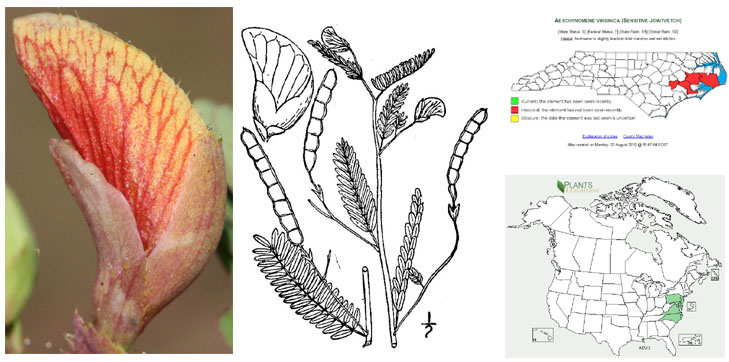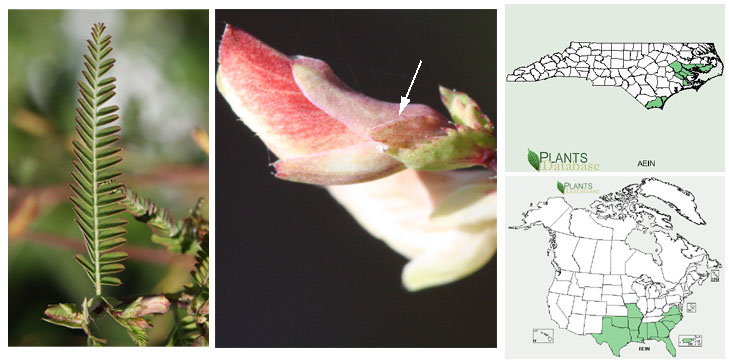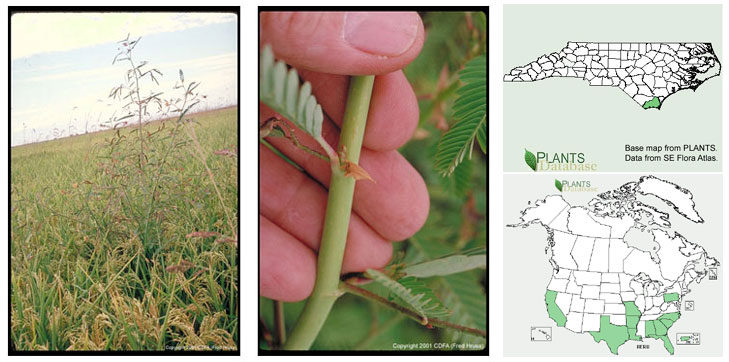Aeschynomene L. (Fabaceae)
Aeschynomene comprises three species in North Carolina, including one exotic from South America (A. rudis). Only Aeschynomene virginica is listed (Fed T, S1 G2). It is one of only three federally listed annuals in North Carolina, the other two being Amaranthus pumilus and Ptilimnium viviparum.
Federally listed taxon–
Aeschynomene virginica (Fed T, State T | S1 G2)
Habitat. Bare to sparsely vegetated substrates in intertidal zone where flooded twice daily, marsh edges, or ditches.
Range. Endemic to the southeastern United States.
Additional resources. NHP |
Recovery plan | 5-yr review
Key to Aeschynomene in North Carolina
Key adapted from Weakley (2008). Photos by Krings, unless otherwise indicated. Line drawings from Britton & Brown (1913). Photos of A. rudis are courtesy of Fred Hrusa (CDFA) and cannot be re-used without his express written permission. Maps courtesy of USDA PLANTS and the North Carolina Natural Heritage Program.
1. Mature fruit stipe ≥ 12 mm long; fruit segments 5–7 x 4.5–6.5 mm; paired bracts subtending each flower toothed (rarely entire); standard greenish-yellow with distinct dark-red veins...A. virginica* 


Habit of Aeschynomene virginica (Photo: Krings)

Leaf of Aeschynomene virginica (Photo: Krings)

Closeup of stem of Aeschynomene virginica (Photo: Krings)

Closeup of rachis of Aeschynomene virginica (Photo: Krings)

Flower detail of Aeschynomene virginica (Photo: Krings)

Detail of immature fruit of Aeschynomene virginica. Note glandular trichomes (Photo: Krings)

Long fruit stipe of Aeschynomene virginica (Photo: Krings)
Aeschynomene virginica*
(rare [Fed T, S1 G2]; fresh or brackish tidal marshes and adjacent lands; CP; mid-summer to fall)
1'. Mature fruit stipe 4–8 (–10) mm long; fruit segments 4–6 x 3.5–6 mm; paired bracts subtending each flower toothed or entire; standard pale orange or reddish-orange, the veins usually indistinct...2.
2. Paired bracts subtending each flower entire (rarely toothed); fruit segments 4–5 x 3.5–5 mm...A. indica 


Aeschynomene indica habit: Flooded roadside ditch Hyde Co. (Photo: Krings)

Aeschynomene indica habit: Flooded roadside ditch Hyde Co. (Photo: Krings)

Aeschynomene indica stem: Flooded roadside ditch Hyde Co. (Photo: Krings)

Flower detail of Aeschynomene indica: Flooded roadside ditch Hyde Co. (Photo: Krings)

Flower detail of Aeschynomene indica: Flooded roadside ditch Hyde Co. (Photo: Krings)

Aeschynomene indica: Flooded roadside ditch Hyde Co. (Photo: Krings)

Aeschynomene indica: Flooded roadside ditch Hyde Co. (Photo: Krings)
Aeschynomene indica
(uncommon; marshes, ditches, disturbed wetlands; CP)
2'. Paired bracts subtending each flower toothed (rarely entire); fruit segments 5–6 x 5–6 mm...A. rudis 
 Aeschynomene rudis
Aeschynomene rudis
(rare; exotic; marshes, ditches, disturbed wetlands; CP)
Similar species
Chamaecrista fasciculata (Fabaceae; shown below) may also occur in ditches in the areas from which species of Aeschynomene are known. In flower, the caesalpinoid, yellow corolla of C. fasciculata could not be confused even at a glance for the papilionoid corolla of Aeschynomene. However, when in fruit, closer examination is warranted. While the fruits of Aeschynomene typically exhibit glandular trichomes (at least when young), the fruits of C. fasciculata exhibit only eglandular trichomes. Vegetatively, C. fasciculata is most easily distinguished by the presence of a petiolar gland (absent in Aeschynomene).

Habit of Chamaecrista fasciculata (Photo: Krings)

Leaf of Chamaecrista fasciculata (Photo: Krings)

Leaf of Chamaecrista fasciculata (Photo: Krings)

Leaf of Chamaecrista fasciculata. Note petiolar gland. (Photo: Krings)

Detail of petiolar gland of Chamaecrista fasciculata (Photo: Krings)

Fruit of Chamaecrista fasciculata (Photo: Krings)

Fruit detail of Chamaecrista fasciculata. Note that trichomes are eglandular (Photo: Krings)



